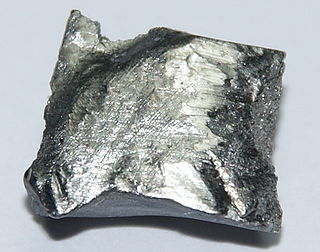Terbium oxide may refer to any of the following:
- Terbium(III) oxide, Tb2O3
- Terbium(III,IV) oxide, Tb4O7
- Terbium(IV) oxide, TbO2
Terbium oxide may refer to any of the following:

Terbium is a chemical element with the symbol Tb and atomic number 65. It is a silvery-white, rare earth metal that is malleable, and ductile. The ninth member of the lanthanide series, terbium is a fairly electropositive metal that reacts with water, evolving hydrogen gas. Terbium is never found in nature as a free element, but it is contained in many minerals, including cerite, gadolinite, monazite, xenotime and euxenite.
Copper oxide is a compound from the two elements copper and oxygen.
Manganese oxide is any of a variety of manganese oxides and hydroxides. These include
A trioxide is a compound with three oxygen atoms. For metals with the M2O3 formula there are several common structures. Al2O3, Cr2O3, Fe2O3, and V2O3 adopt the corundum structure. Many rare earth oxides adopt the "A-type rare earth structure" which is hexagonal. Several others plus indium oxide adopt the "C-type rare earth structure", also called "bixbyite", which is cubic and related to the fluorite structure.

Chlorine and oxygen can bond in many ways:
Cerium oxide may refer to:
Chromium oxide may refer to:

Terbium(III,IV) oxide, occasionally called tetraterbium heptaoxide, has the formula Tb4O7, though some texts refer to it as TbO1.75. There is some debate as to whether it is a discrete compound, or simply one phase in an interstitial oxide system. Tb4O7 is one of the main commercial terbium compounds, and the only such product containing at least some Tb(IV) (terbium in the +4 oxidation state), along with the more stable Tb(III). It is produced by heating the metal oxalate, and it is used in the preparation of other terbium compounds. Terbium forms three other major oxides: Tb2O3, TbO2, and Tb6O11.

Terbium(III) bromide (TbBr3) is a crystalline chemical compound.
Terbium(III) chloride (TbCl3) is a chemical compound. In the solid state TbCl3 has the YCl3 layer structure. Terbium(III) chloride frequently forms a hexahydrate.
Terbium(III) iodide (TbI3) is an inorganic chemical compound.

Terbium(III) oxide, also known as terbium sesquioxide, is a sesquioxide of the rare earth metal terbium, having chemical formula Tb
2O
3. It is a p-type semiconductor, which conducts protons, which is enhanced when doped with calcium. It may be prepared by the reduction of Tb
4O
7 in hydrogen at 1300 °C for 24 hours.

Terbium(III) nitrate is an inorganic chemical compound, a salt of terbium and nitric acid, with the formula Tb(NO3)3. The hexahydrate crystallizes as triclinic colorless crystals with the formula [Tb(NO3)3(H2O)4]·2H2O. It can be used to synthesize materials with green emission.
Terbium(IV) oxide is an inorganic compound with a chemical formula TbO2. It can be produced by oxidizing terbium(III) oxide by oxygen gas at 1000 atm and 300 °C.

Terbium(III) hydroxide is an inorganic compound with chemical formula Tb(OH)3.

Terbium(IV) fluoride is an inorganic compound with a chemical formula TbF4. It is a white solid that is a strong oxidizer. It is also a strong fluorinating agent, emitting relatively pure atomic fluorine when heated, rather than the mixture of fluoride vapors emitted from cobalt(III) fluoride or cerium(IV) fluoride. It can be produced by the reaction between very pure terbium(III) fluoride and xenon difluoride, chlorine trifluoride or fluorine gas:

Terbium compounds are compounds formed by the lanthanide metal terbium (Tb). Terbium generally exhibits the +3 oxidation state in these compounds, such as in TbCl3, Tb(NO3)3 and Tb(CH3COO)3. Compounds with terbium in the +4 oxidation state are also known, such as TbO2 and BaTbF6. Terbium can also form compounds in the 0, +1 and +2 oxidation states.
Cerium compounds are compounds containing the element cerium (Ce), a lanthanide. Cerium exists in two main oxidation states, Ce(III) and Ce(IV). This pair of adjacent oxidation states dominates several aspects of the chemistry of this element. Cerium(IV) aqueous solutions may be prepared by reacting cerium(III) solutions with the strong oxidizing agents peroxodisulfate or bismuthate. The value of E⦵(Ce4+/Ce3+) varies widely depending on conditions due to the relative ease of complexation and hydrolysis with various anions, although +1.72 V is representative. Cerium is the only lanthanide which has important aqueous and coordination chemistry in the +4 oxidation state.
Terbium fluoride may refer to: